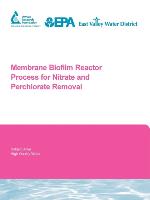Membrane Biofilm Reactor Process for Nitrate and Perchlorate Removal
BücherAngebote / Angebote:
The objectives of this project were to evaluate the performance of an innovative hydrogen-fed membrane biofilm reactor (MBfR) for nitrate and perchlorate removal, and identify the system operational and design parameters that affect the biological reduction process.
The MBfR contained hollow-fiber membranes within a cylindrical module. Hydrogen was fed to the fibers filling the inside and passively diffusing through the membrane avoiding the formation of a hydrogen atmosphere and serving as an electron donor for the biofilm growing on the outside of the hollow fibers. The biofilm within the reactor was developed from the indigenous bacteria present in the groundwater and was not artificially inoculated or amended.
Following the MBfR, an aeration process was employed to oxygenate the water in preparation for its introduction into a distribution system as a drinking water source. A subsequent media filter captured any sloughed biomass and provided a support for aerobic organisms to remove any residual dissolved hydrogen.
Process Demonstration
The MBfR process was demonstrated at pilot-scale to reduce perchlorate contaminated groundwater (55 µg/L) to below the current 4 µg/L California Department of Health Services (CaDHS) perchlorate action limit. The simultaneous removal of influent dissolved oxygen and nitrate to below detection limits was also observed. Their removal has been observed with the MBfR system operated at system flow rates corresponding to theoretical hydraulic residence times between 15 and 60 minutes. In addition, measured hydrogen consumption closely matches theoretical calculations based on stoichiometry and anaerobic biomass development.
Microbial Ecology
Bench-scale investigations into the microbial ecology of the mixed cultures in MBfRs revealed that perchlorate reducing bacteria (PCRB) were found to be present in a denitrifying system that had not been previously exposed to perchlorate. However, a dominant PCRB species increased from 14 to 21 percent of total bacteria when 100-µg/L perchlorate was added to the influent. Increasing perchlorate reduction led to further increases in the dominant PCBR and the perchlorate-removal capacity of MBfRs. Another important finding is that oxygen alone can serve as a primary acceptor for perchlorate reduction, and that the oxygen reduction appeared to be more favorable for perchlorate reduction than was nitrate reduction.
Ultimately, full-scale application MBfR technology could effectively and economically be used to replace costly treatment technologies currently used by municipalities to treat perchlorate-contaminated drinking water sources. This research defined the critical parameters and operating conditions required for full-scale application and provided an extensive review of the critical water quality issues considered for drinking water by CaDHS and other state primacy agencies.
In addition, this project has direct relevance to the application of biological treatment for the removal of nitrate (or other biologically reducible compounds) from contaminated groundwater. For a long time, biological denitrification has long been used in wastewater treatment, but not in drinking water treatment. Due to concerns about operating a biological process in a water treatment plant, nitrate removal in the United States has been largely limited to ion-exchange or membranes, both of which are expensive processes and can generate difficult to handle residuals. The results obtained in this study looked at simultaneous biological perchlorate removal and denitrification.
Folgt in ca. 15 Arbeitstagen




